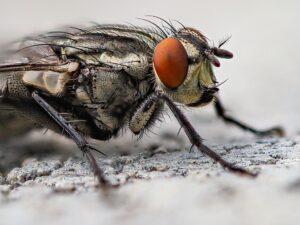America uses sterile flies to protect itself against the flesh-eating parasite – Mexican animal exports have stopped again
The United States has again suspended live animal imports from Mexico after a resurgence of a parasitic fly infestation near its southern border. The pathogen has already caused massive damage in the region and is now threatening Texas livestock. The US government has announced the construction of a new sterile fly breeding plant to combat the disease.
 The flesh fly, whose larvae develop in the wounds of live animals, causes a rapid and brutal infestation. The female can lay up to 300 eggs in a fresh wound, from which the larvae hatch within a few hours, burrow into the flesh and begin to destroy the victim from the inside. A single untreated infestation can kill a healthy cattle herd in less than two weeks.
The flesh fly, whose larvae develop in the wounds of live animals, causes a rapid and brutal infestation. The female can lay up to 300 eggs in a fresh wound, from which the larvae hatch within a few hours, burrow into the flesh and begin to destroy the victim from the inside. A single untreated infestation can kill a healthy cattle herd in less than two weeks.
The infection primarily affects cattle – in 83 percent of cases – but can also occur in domestic animals and, rarely, in humans. The Department of Agriculture has again suspended imports of cattle, horses and bison from Mexico as of July 10, as data from the southern Mexican state of Veracruz indicates new outbreaks.
The United States responded by closing its border in May, but the easing planned for July has now been postponed. The decision could also have a significant impact on US beef prices, as Mexico is one of the largest suppliers. Prices rose to record levels during the previous closure.
The control is not done by classic insecticides, but by a biological method: sterilized male flies are released, which make wild females infertile. This strategy worked in the 1960s, but now a much larger scale intervention is needed.
Currently, a Panamanian factory is breeding about 100 million sterile fly larvae per week, but this is not enough. The US government has announced plans to build a new “fly factory” in Texas, near the Mexican border. The $8.5 million facility, located at Moore Air Force Base, will be able to produce 300 million sterile insects per week. The insects will be released from airplanes, mainly in sparsely populated areas where the infestation is common.
The control is not only expensive but also labor-intensive: farmers must check their animals daily. Treating infected wounds requires disinfection, dressing, and antibiotic treatment. Since the flesh fly can also colonize wild animals, such as deer and birds, controlling the infestation is a major challenge.
The Department of Agriculture says the investment is worth it: if the infestation were to spread, it could cause up to $10 billion in damage to livestock production annually. “If we have to spend $300 million to avoid $10 billion in losses, that’s out of the question,” said a Texas farmer.
Related news
A digital milestone in the life of Ahold Delhaize USA
🎧 Hallgasd a cikket: Lejátszás Szünet Folytatás Leállítás Nyelv: Auto…
Read more >Trump’s tariff cuts could reshape the global food market
🎧 Hallgasd a cikket: Lejátszás Szünet Folytatás Leállítás Nyelv: Auto…
Read more >This is how Hungarian companies can prepare for the new global trade order
🎧 Hallgasd a cikket: Lejátszás Szünet Folytatás Leállítás Nyelv: Auto…
Read more >Related news
The 6 most important payment trends in 2026:
🎧 Hallgasd a cikket: Lejátszás Szünet Folytatás Leállítás Nyelv: Auto…
Read more >Tourism continues to expand dynamically
🎧 Hallgasd a cikket: Lejátszás Szünet Folytatás Leállítás Nyelv: Auto…
Read more >FEOSZ creates a certificate for consumer-friendly web stores
🎧 Hallgasd a cikket: Lejátszás Szünet Folytatás Leállítás Nyelv: Auto…
Read more >







